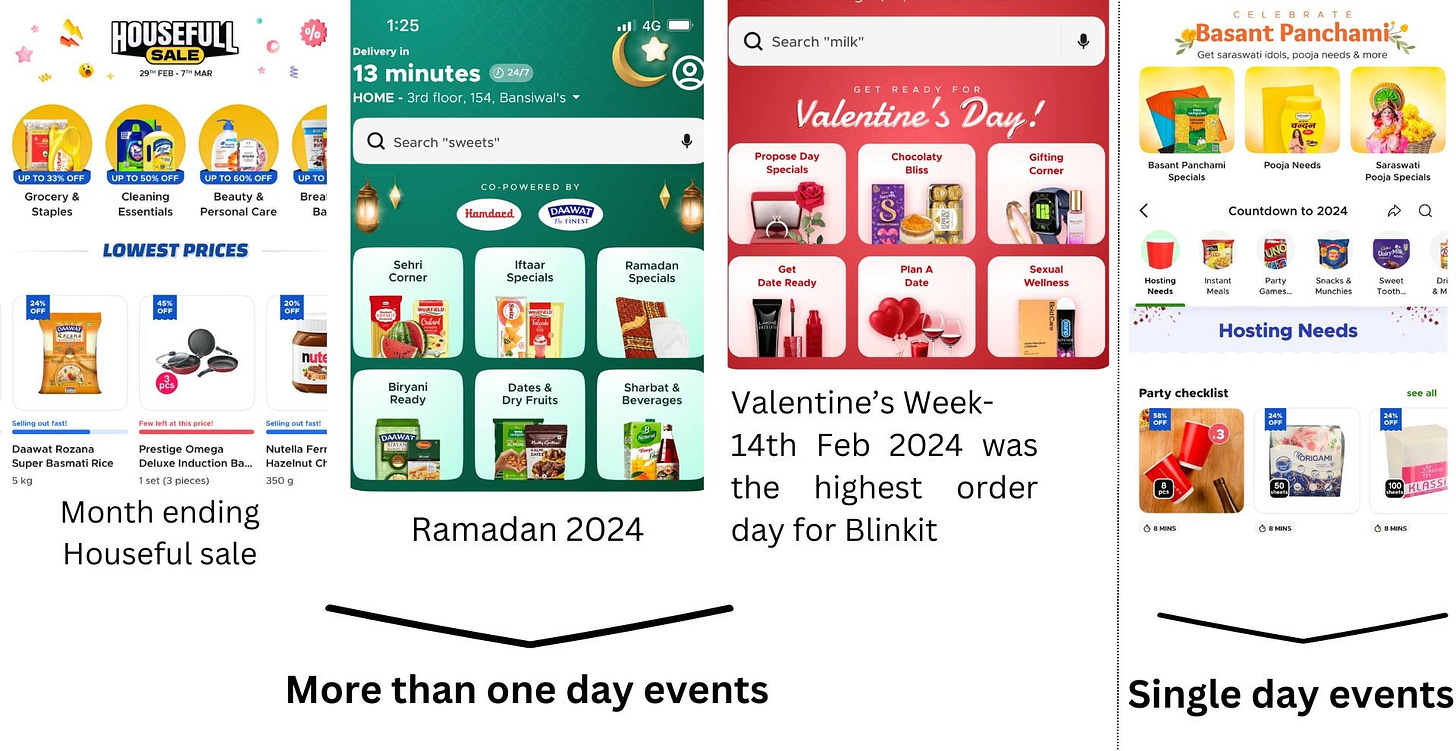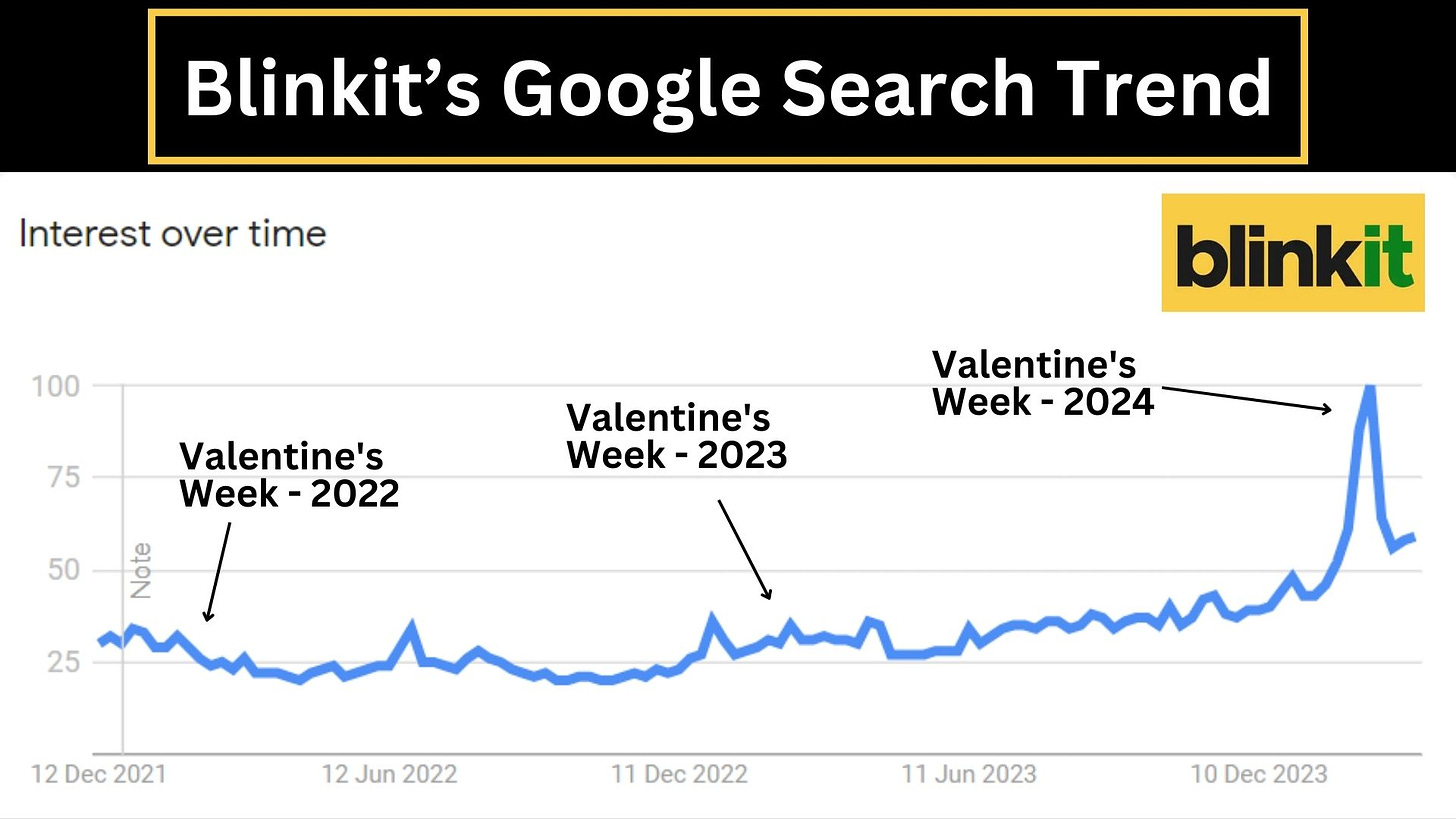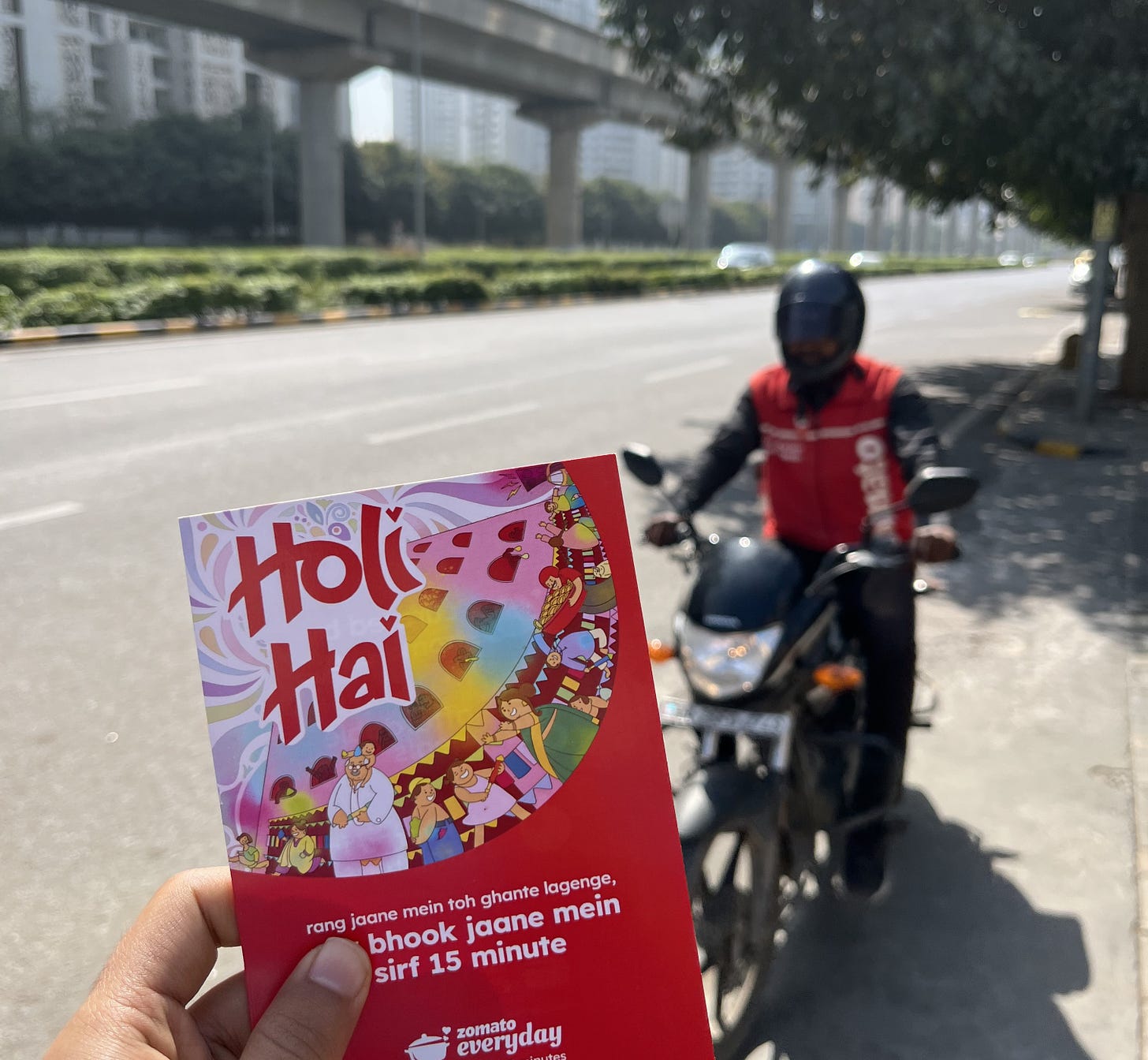Quick Commerce (QC) is proving everyone wrong - From industry experts, to CEOs of Retail giants to professors of IIMs to professionals on social media platforms like LinkedIn - all of them came up with valid pointers in the last 1-2 years since QC started in post covid India. An industry which never existed before, and hardly any comparable in the international markets, no one actually knows how to benchmark the success of it.
Towards the end, I shall also talk about Zomato’s latest initiative in Gurugram, which is about to be launched at a large scale in key Indian cities and can lead Indians towards ‘kitchen-less’ households. It's worth noting that my perspective may be somewhat biased as I am bullish on Zomato (which is also the parent company of Blinkit) and hold shares in my portfolio. However, I'll strive to present this blog with minimal bias. Prefer reading this blog on web/substack app considering the length of the blog.
“Problem is 10Min delivery has no economics - low ticket size and low margin can never be solved through forced low delivery cost.” - Ashneer Grover, the former CFO of Grofers (now known as Blinkit), on Quick Commerce business model in India.
What did the expert say?
Here's a video which I want you to see before you read further. Ashneer explains the economics of online ordering and why Quick Commerce (QC) doesn’t seem logical to him. He uses examples to illustrate his point: for instance, he discusses how Nykaa profits from selling high-margin beauty products, and how Flipkart earns from selling high-ticket items like mobile phones, allowing them to generate substantial profits with each sale. Tap on the the video below and watch it for just 1 minute:
He assumes that the order size for Quick commerce would be small and since the margins in groceries are less, it would not be sufficient for the unit economics to make sense. By the way, he wasn’t alone with this thought process. Amongst India’s biggest retailer - Big Basket’s CEO Hari Menon also shared a similar view - “The economics just don’t work at 10-15 minutes, which is frankly a fact.” Many scholars and professors of IIMs did share similar views with one of them saying - “There are ‘n’ number of ways to get it wrong”.
I feel it's normal for humans to be in denial or cling to the status quo when facing significant changes in their environment. I recall vividly the launch of Zepto in 2021, introducing the concept of under 10-minute delivery - my LinkedIn and Twitter feeds were inundated with opinions from numerous professionals debating the sustainability and safety of this business model. Many questioned the necessity of '10-minute' delivery, opting instead to purchase from local grocery stores.
In another instance, in May of 2023, during a period of slower sequential growth in the QC industry for a few months, the CEO of BigBasket remarked that these high-growth businesses would 'soon settle down' (implying slower growth ahead), indicating that this was already beginning to occur. Fast forward to today, here are 2 facts one must note -
BigBasket is today 4th biggest Quick Commerce player in India
CEO’s expectations were completely wrong & he now admires QC
“Consumers have lapped it up …. they(consumers) have liked the service and now I think quick commerce is here to stay” - BigBasket’s CEO Hari Menon in March, 2024
The bar chart above is an example for you to about the fact that ‘Quick Commerce’ industry is so unpredictable that even industry veterans are getting it completely wrong. Blinkit’s revenues have grow 85% sequentially in period of 6 months since that comment came in and is about to turn EBITDA positive. Its competitor Zepto also has touched $1 Bn mark in ARR and is expected to reach $1.5 Bn ARR and EBITDA positive soon in next few months. We are currently witnessing how habits of affluent Indians is getting transformed with this service.
Indian Habits are changing!
When I first started working and shifted to Gurugram in 2022 from my hometown Ludhiana, life got tougher and suddenly I had no time for myself. Living away from family, I got completely dependent on online ordering food daily but not for groceries. I preferred going to the local shop to buy fruits and daily groceries. It was only after mid-2023 when my usage of Quick-commerce apps suddenly accelerated and I started preferring comfort of staying at my room over stepping out and walk for 5 minutes. The variety that these apps offer is amazing. It helped me with a new product discovery namely ‘Quaker Multigrain’ Oats which are actually my favorite now, and I don’t find in any of my local shops.
I am not alone. A recently published article of 28 February, 2024 in Economic Times tells a similar story of how many bachelors and housemakers have started preferring comfort of ordering from their bed even before starting their day. The impact is clearly visible on grocery shops that are located in micro markets recognized by high density population. The article also mentions how kirana shop owners in these micro markets have started feeling the pain.
Our sales are down by at least 15%. But for select items like soft drinks and packaged snacks, the decline is as high as 25%. Our regular customers tell us that they frequently buy from quick commerce. - A Kirana Shop Owner (Source ET)
I also went to my local shops to enquire about the same - the impact is real! The kirana owner tried to convince me for not ordering from such online apps as quality of even branded product is compromised which I actually never have experienced till date despite order over 50+ times now. The impact can also be judged by the sales split of India’s biggest FMCG companies such as Nestle India, Parle, ITC, Marico and Emami where quick commerce platforms now contribute 30-50% of their annual e-commerce sales from 0% just 2 years ago.
“Whatever we add to quick commerce seems to get lapped up instantly. It is now about half of our online business” - Suresh Narayanan, Chairman of Nestle.
Its not just Groceries anymore!
Being a listed company, every time Zomato’s quarterly concall is held to discuss the results of quarter gone by, research analyst tend to always question the split between groceries and non-groceries sales of their platform Blinkit, which the management refuses to share. This is because the team there has been focusing on improving the product categories available on their platform for over a year now. If one has to take the count of mentions of word ‘category’ in con-calls of Zomato, you would understand how the interest has been rising over every quarter:
Sachin Salgaonkar and his team of Bank of America hosted internet strategy consultants in last week of February of 2024 to estimate the possible split of category wise sales split (GMV) of items happening on quick commerce and this is what they concluded:
Grocery including fresh & staples is ~40-50%
Share of electronics and home office is ~30%
Beauty and Personal Care (BPC) is ~20-30%
Now these results are very encouraging as the electronics and BPC are categories where Flipkart and Nykaa were taking away the profit pool before - the point from where we started today’s blog. These categories help in boosting the order value and improving the unit economics for quick commerce ecosystem. I also feel that categories where the products are fairly standardized, frequency of purchase during a year is low and level of urgency is relatively high, quick commerce can act as a game changer. Think of purchasing gold coin on Dhanteras, or purchasing a book to read it in flight that takes of in 2 hours, or requiring a headphone before an important meeting as you misplaced yours existing one, to purchasing a trimmer because yours one suddenly stopped working. And end of the day its all about habits. Even when the urgency is not high, a customer who has already witnessed quick delivery service, might not wait for a product to be delivered after 2 days when he can get it delivered in 10 minutes. This behavior has the potential of making humans more impulsive then planned while making their purchase decisions.
Not just this, the most profitable portion of Blinkit’s business is actually its advertisement business. As per BofA research, Ad-revenues is currently 2-2.5% of GMV (GMV can understood as total sales happening on Blinkit’s platform) and could reach to 4 - 5% of GMV as the brands are happy to target their potential customer user-base. This means that currently for every Rs 100 of sale value happening on Blinkit’s platform, they make ~Rs 2 worth of ad income which is highly profitable portion of total revenue and are expected to make Rs 5 in future from that much of sales.
Advertising - The money spinner
Zomato has been one of the few companies of India where I find high level of similarities with Big Tech giants of America. I know their business models are different but one thing which I want to put spotlight on is how much money Big Tech make from Ads. About 80-90% of Alphabet and Meta's total revenue comes from digital advertising. A better comparison to Blinkit would be Amazon who earned ~$ 46 Bn in revenues from just Advertising services in 2023.
Advertising on Quick Commerce can be very targeted. Lets take example of Maggie ads on Blinkit which are more visible especially in late night hours as impulse purchase might push to get it delivered in 10 minutes and consume. On similar lines is the case of sexual wellness products and condoms who ads are more visible in evening. Home decor ads generally come over the weekends by Trident and when any the stock goes out of inventory in a particular micro market, software can immediately stop showing the ad. This level of customization which didn’t exist at time of TV, got solved to some extent with internet, but now with impulsive nature kicking in, these ads have the ability to generate highest ROI for brands than all other means.
India is full of festivals, whether is national or international or regional special days, QC is a life saver when it comes to festive season. And QC (Blinkit in particular) has done an amazing job in acquiring maximum customers via the application UI/UX, marketing efforts, along the vast variety of goods that are available on their platform. For a company like Blinkit, who's prime sales week actually happens to be around the New Year, February month was special. A simple Toggle button on their app for users to switch between 'Singles' and 'Committed' mode before the Valentine's week along launch of multiple new categories on the app led to whole India talking about it.
1. Content creators jumped in and started making content around Blinkit's app on all social media platforms along on Youtube
2. Reels on Instagram went viral
3. App downloads of Blinkit briefly crossed Zomato's daily app download on Appstore and stayed above Swiggy's download for most of Feb and even March
The impact was clear from the google trends data where the brand's search made new peak, which was 3X to 4X compared to previous year's Valentine's week and about 2X over recent New year week. Moreover, it was also sustaining even after the February month got over, in the March's search data.
And brands and FMCG giants love it. This is because the impulsive instinct is highest around special days combined with increased willingness to spend helps brands make customers try new products by getting it added to their cart. It improves ROI on their marketing spend and that is where I find Quick commerce can be more profitable than other channels because brands and FMCG giants are happy to spend their huge marketing budgets on promoting products on these apps to help consumer experience their new launches quickly. The ability of the quick commerce players to turn into a daily ordering app from an occasion based app is where the 10X moment lies.
Learning from subsidiary - The Blinkit way!
Zomato is not only focusing on growing Blinkit across India, but also integrating the positives of its business model into Zomato’s own food model. As I write in month of March 2024, Zomato is opening over 16 dark kitchens in Gurugram under its new initiative - ‘Zomato Everyday’. For last 1 year, this initiative was in a trial mode here, became a top selling restaurant with over 80K+ ratings, and now it’s getting set for a full blown launch. The intent is to provide fresh home quality food, at affordable rates to people working away from their hometowns. Living in Gurugram, I have been trying out ‘Everyday’ very often and have ordered over 50+ times in last 1 year. Now as they are revamping up the operations by opening new kitchens, they are adding the latest feature of ‘delivery under 15 minutes’ to this initiative.
Here is me, whose breakfast got delivered in 11 minutes today:
As Zomato’s founder Deepinder Goyal says - India is moving towards ‘kitchen-less households’, Zomato Everyday is the first step towards that, and has the potential for Zomato grow its food delivery by 15X in years to come.
That’s it for today’s blog and I hope you enjoyed reading it. I shall continue with this research around how the story is unfolding in coming months.
Wondering how you can support us?
If you find our content valuable & are willing to support, show some love here⬇️
Disclaimers-
We are not SEBI registered advisors; personal investment/interest in the shares exists for the company mentioned above; this isn’t investment advice but our personal thought process; DYOR (do your own research) is recommended; Investing & trading are subject to market risk; the Decision maker is responsible for any outcome.









LOVELY WRITUP WITH GREAT INSIGHTS
Insightful